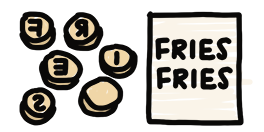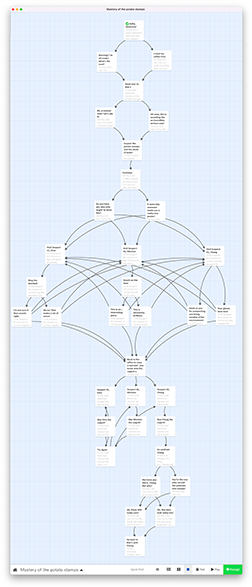Mystery of the potato stamps

The potatoes that Bob bought to make fries have been mysteriously carved into potato stamps. Which of the three new neighbours is the culprit? You, a super awesome detective, along with your equally awesome partner Detective Jocelyn, are on the case!
Click here to open Mystery of the potato stamps in a new tab for the full experience (recommended), or play a tiny version of it below.
Reflection
Strategy
The concept of creating branching scenarios is not new to me, but this was my first time making a text-based game and using Twine! I used to love the text-based Stickman murder mystery games, so I was very excited to create my own for this task.
In branching scenarios, the player is “give[n] the illusion of control” but the paths are determined by the creator (Bolter, 2010, p. 43), and I’m mindful that this makes for a certain “relationship between the [player] and the text” (p. 35). Considering this, to help minimize feelings of being forced to say certain things or take certain paths, I set out to write opposing choices for the player to ‘say’ or do whenever possible, such as:
-
- “I’m all ready!” / “I need my coffee first.”
- “I’m not sure if that sounds right.” / “That makes a lot of sense!”
Creation process
1. Prewriting: I started with what Bolter (2010) referred to as “prewriting” (p. 33). I decided on the theme, clues, and characters, and mapped out the major branches.
2. Design: I knew I would be jumping between descriptions, dialogue, and choices, and I wanted to ensure that these are presented clearly to the player. I tackled this using light CSS and HTML.

3. Build: I simultaneously created the branches, decided on details, and wrote the text directly in Twine. I especially appreciated Twine in this step of the process – I was reminded of Bolter’s (2010) description of an “electronic writing space” (p. 35), in that I found Twine effective in “tak[ing] care of the mechanics of maintaining and presenting both networks and trees” (Bolter, 2010, p. 35), which allowed me to focus on writing whatever came to mind!
4. Add images: I created quick sketches for key elements and added them in.
References
Bolter, J. D. (2010). Hypertext and the remediation of print. In Writing space: Computers, hypertext, and the remediation of print (pp. 27-46). Routledge.
Normandcompany. (n.d.). Stickman murder mystery games. Internet Archive. Retrieved from https://web.archive.org/web/20060807005748/http://www.normandcompany.com/STICKMAN/index.html
